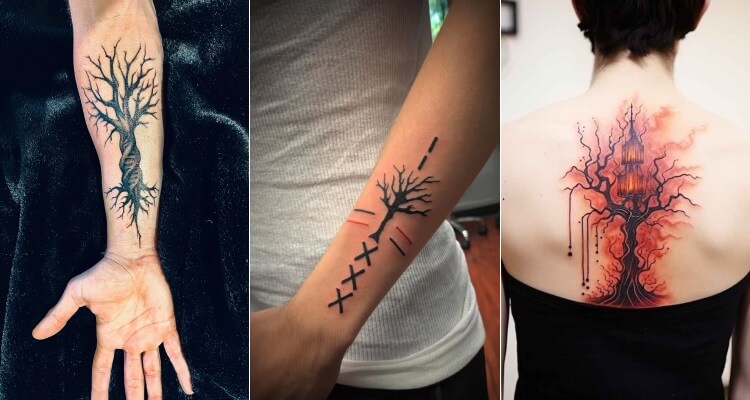Discover the deep meanings, symbolism, and artistic interpretations behind the poison tree tattoo. Learn why this powerful ink resonates with those on a journey of growth, pain, and transformation.
The Allure of the Poison Tree Tattoo
A poison tree tattoo isn’t just another cool ink design. It carries with it layers of meaning, emotional depth, and a rich literary background that makes it stand out in the world of tattoos. For anyone looking for a design that’s both symbolic and artistically captivating, the poison tree tattoo delivers on all fronts.
You don’t have to be a literary geek or a dark soul to appreciate this tattoo. It’s for those who have dealt with emotional turmoil, hidden anger, or personal transformation. It’s also for the ones who appreciate nature with a twist—a tree that looks serene but is laced with danger. This duality makes the poison tree tattoo one of the most intriguing designs out there.
Symbolism Rooted in Literature and Emotion
The poison tree tattoo draws inspiration from the iconic poem “A Poison Tree” by William Blake. In the poem, suppressed anger grows metaphorically into a deadly tree, symbolizing how hidden emotions can fester and become destructive. When you ink this poem into your skin, you wear a cautionary tale and a personal reminder all at once.
But it doesn’t stop there. This tattoo isn’t just about anger or revenge. It can also symbolize internal growth, transformation through pain, or the ability to hide one’s struggles beneath a calm surface. It’s like carrying a piece of art that narrates your emotional journey without needing any words.
Whether you’re expressing bottled-up feelings or showcasing resilience, the poison tree tattoo does the job with grace and grit. It’s moody, beautiful, and real—a perfect storm of artistic expression.
The Aesthetics of a Poison Tree Tattoo
Visually, a poison tree tattoo can be both haunting and breathtaking. Artists often incorporate twisted roots, gnarled branches, and sometimes even fruit or skull motifs to emphasize the “poison” aspect. The contrast of beauty and danger makes the design stand out in any tattoo portfolio.
Many people choose black and grey for a more gothic feel, but adding pops of color like blood-red apples or green toxic sap can elevate the design to another level. Some opt for a more minimalist sketch, while others go full-on surrealist. The customization potential is endless, which is why this tattoo is growing in popularity.
Placement also plays a role in its aesthetic impact. A poison tree tattoo can look dramatic down the spine, symbolic on the chest, or intricately detailed on the forearm. Wherever it’s placed, it demands attention and sparks curiosity.
Why People Choose a Poison Tree Tattoo
This tattoo often resonates with those who have been through emotional or psychological struggles. It serves as a visual metaphor for buried pain, unresolved anger, or emotional growth. Sometimes, it’s a form of therapy through art.
Others see it as a badge of transformation. Just like a tree absorbs toxins from the soil, some people believe they’ve absorbed pain and turned it into strength. That poison becomes part of their story, but it no longer controls them. In this way, the tattoo becomes not a warning but a triumph.
And let’s not forget the aesthetic appeal. There’s something undeniably edgy and sophisticated about a tattoo that combines nature with an ominous twist. It’s not just a tree; it’s a symbol of resilience, duality, and mystery.
Design Variations and Creative Interpretations
There are countless ways to design a poison tree tattoo, depending on your personal story and style preferences. Some people lean into the dark poetry of it, with shadowy branches and a foreboding atmosphere. Others bring out its gothic beauty with intricate line work and contrasting textures.
Adding elements like a snake, a withered apple, or even a hidden heart can deepen the meaning. Each addition serves to enhance the narrative you want your tattoo to tell. You can also incorporate quotes from Blake’s poem or other literary lines to personalize the piece even more.
For the artistically inclined, watercolor styles can make the poison tree look like it’s bleeding into your skin. Realistic bark textures and eerie lighting effects can give it a hyperrealistic feel. The poison tree is a versatile canvas for storytelling.
Cultural and Spiritual Connections
The idea of a poison tree isn’t just a Western literary symbol. Many cultures have similar myths and symbols. In some folklore, sacred trees can turn dangerous if disrespected. In others, certain trees are believed to house spirits or act as bridges to other realms.
The poison tree tattoo can thus tap into deeper spiritual meanings. It might represent a connection to nature’s darker side or a protective symbol warding off negative energy. Some see it as a personal totem of survival and strength through adversity.
There’s a raw, primal element to it as well. Trees have long been seen as life-givers and sustainers. By inking a “poisoned” version, you’re acknowledging both creation and destruction—a balanced, grounded worldview.
Poison Tree Tattoo for Men
For men, a poison tree tattoo often represents strength forged through inner conflict. It can be a statement piece about overcoming anger, hiding pain, or surviving life’s darker chapters. Many men opt for bold, masculine designs that emphasize texture, contrast, and symbolism.
From a stylistic standpoint, larger formats like back pieces or chest tattoos allow for more detail. Add elements like ravens, skulls, or crumbling roots, and you have a piece that speaks volumes without uttering a word. It’s a nod to both vulnerability and resilience.
Poison Tree Tattoo for Women

Women often gravitate toward more nuanced interpretations. Their designs may include delicate branches with subtle toxic elements, like a beautiful blossom with thorns or a graceful tree with sinister shadows. These tattoos are often about empowerment through emotional depth.
A poison tree tattoo for women can be minimal or elaborate, depending on what they want to convey. It might highlight a healing journey, a transformation, or the complexity of human emotion. Feminine styles like fine lines, shading, and subtle color work well here.
Meaningful Add-Ons and Symbols
To make your poison tree tattoo even more personalized, consider adding meaningful symbols. Here are a few ideas:
| Symbol | Meaning |
|---|---|
| Snake | Hidden danger, transformation |
| Apple | Temptation, betrayal |
| Raven | Death, mystery, inner wisdom |
| Heart | Pain, emotional truth |
| Moon | Cycles, inner shadows |
Adding these symbols can deepen the narrative and make your tattoo a multi-layered piece of art.
“A tattoo is not just ink. It’s a living story.” — Anonymous
Healing Through the Ink: Emotional Catharsis
Many people find getting a poison tree tattoo to be deeply therapeutic. It’s a way to externalize internal struggles, making them visible and therefore manageable. When pain becomes art, it stops being a burden and starts being a badge of honor.
This isn’t about glorifying suffering. It’s about acknowledging it, owning it, and moving forward. For many, the poison tree becomes a symbol of healing—a visual reminder that what once hurt you helped shape you.
Ideal Placement for Maximum Impact
Choosing where to place your poison tree tattoo is as important as the design itself. Popular spots include:
- Forearm: Easily visible and great for detailed work.
- Back: Offers a large canvas for epic, story-driven designs.
- Ribs: Painful but intimate, ideal for personal meaning.
- Legs or thighs: Perfect for long, twisting branches.
- Chest: Symbolic placement over the heart or lungs.
The placement can enhance the story you’re trying to tell. Talk to your tattoo artist about what makes sense both emotionally and visually.
Quotes to Include with Your Tattoo
Adding a quote to your tattoo can enhance its meaning. Here are some lines that go perfectly with a poison tree theme:
- “I was angry with my foe: I told it not, my wrath did grow.” — William Blake
- “Even poison has its beauty.”
- “Out of darkness, I grew.”
- “Not all trees offer shade.”
- “What feeds me also poisons me.”
These quotes can be inked in elegant scripts, wrapping around branches or hidden in the roots.
FAQs About Poison Tree Tattoos
Q: What does a poison tree tattoo symbolize?
A poison tree tattoo often symbolizes suppressed emotions, hidden anger, personal transformation, or the complexity of human nature.
Q: Is it inspired by William Blake’s poem?
Yes, many poison tree tattoos are inspired by Blake’s poem “A Poison Tree,” which explores the dangers of hidden wrath.
Q: Is it a popular design for both men and women?
Absolutely. Both men and women get this tattoo, although the styles and interpretations might vary based on personal meaning.
Q: What symbols can I add to make it more meaningful?
Common add-ons include snakes, apples, ravens, hearts, and moons. Each adds a layer of symbolism and helps tell a unique story.
Q: Does it always have to look dark or gothic?
Not at all. While many choose a darker aesthetic, it can also be minimal, colorful, or abstract. The meaning is what counts.
Q: Where should I place my poison tree tattoo?
Popular spots include the forearm, back, ribs, and chest. It depends on how visible and large you want the design to be.
Final Thoughts: The Poison Tree Tattoo is More Than Just Ink
A poison tree tattoo is one of those rare pieces of body art that combines emotional storytelling with striking visuals. Whether you choose it for its literary roots, emotional depth, or artistic appeal, one thing’s certain: it’s a tattoo that tells a powerful story.
Wear it not just as a warning or a memory, but as a living testament to growth, resilience, and the beauty found in darkness.




